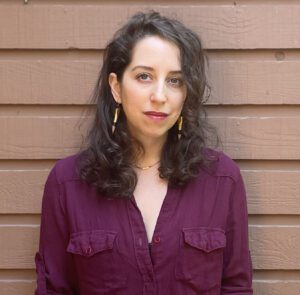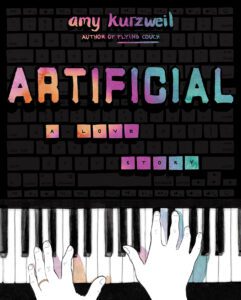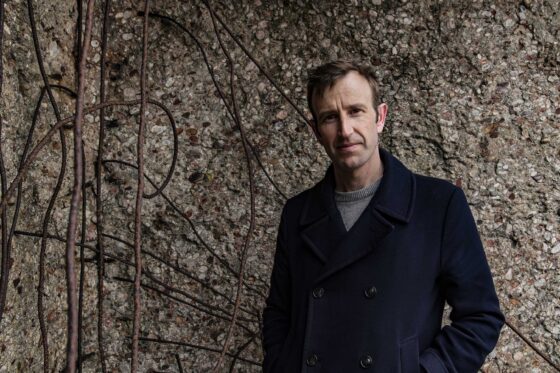
In Artificial: A Love Story (Catapult, 2023), renowned futurist and inventor Ray Kurzweil asks his daughter, Amy, a graphic memoirist and the book’s author, to help him with an ongoing project: he is constructing a chatbot of his own father, a Viennese musician named Fred. Kurzweil is curious to delve into her grandfather’s legacy; she is very close with her parents and previously explored her mother’s side of the family in her first graphic memoir, Flying Couch (Catapult, 2016). But what she discovers through the project and what readers find in Artificial is far more than the results of a technological experiment.
Artificial is a deeply personal record of Kurzweil’s exploration of creativity, memory, and the limitless search to more fully understand the people we love—and love the people we understand more fully. The book spans years of Kurzweil’s life as well as generations of her family’s over hundreds of pages of black-and-white drawings.
Kurzweil’s comics regularly appear in The New Yorker, and there’s plenty of her typical style here too: scenes of unspoken emotional tension, beautifully inked and watercolored in shades of gray. But the book includes a wealth of other visual approaches, too, like a graphic film strip of a habit repeated over and over, a realistically detailed cache of paperwork, and a more sketchily rendered story from Fred’s past. While her father’s theories on AI begin the story, Kurzweil’s commitment to holding onto uncertainty and visualizing how knowledge can offer new perspectives without answers carries the reader well past technology’s limitations.
Kurzweil invited me to her sunny apartment, where we sat at her kitchen table, surrounded by art and family artifacts, to discuss the creative process, whether or not the breadth of the human experience can be captured in an archive, and the Fred bot AI as a kind of memoir.
***
The Rumpus: Artificial is a big book, both in size—368 pages and large-format—and in scope. I’m curious about how you approached such a weighty and varied project from the start.
Amy Kurzweil: It took seven years to write, and it’s the kind of book that you’re living as you’re writing. Part of that is that life intervenes and changes your ideas about what the book is about, or what you want to highlight. For example, the pandemic happened in the middle of the book and ended up becoming a plot point but not necessarily as big a plot point as it felt like it should be while it was happening.

Practically, my process starts with research and reflection. In this case, I spent a lot of time in my grandfather’s archives in Boston. I was living in New York at the time, so that would involve trips home to see my parents and go into these archives. I also started documenting my time visiting the archives because I realized the process was relevant to the themes of the book. So I would go to the archives and take lots of pictures, creating this shadow digital archive.
I also spent time writing reflectively about themes that I knew were going to come up in the book. And I sat down and specifically started scripting chapters because I had the insight that the book needed to be organized thematically and that certain scenes and memories from my life were going to be mapped onto these overarching themes. For example, “Pattern Recognition” is the title of the first chapter. The second chapter is titled “Immortal Virtue,” and it’s about immortality. The third chapter is titled “How Do You Know?” and it’s about knowledge. I wanted these esoteric themes to be grounded in experiences and memories and characters. Then I found the narrative voice that’s pushing the reader through the whole book: it’s me reflecting and trying to bring everything together. The narrative voice was the hardest thing to figure out. And I think I still have critiques of how it’s working. But it is the thing trying to make it all feel unified.
I think some cartoonists really go into detail in their scripts because they see it already. That’s not how my mind works. I don’t have a very vivid mind’s eye for comics. Actually, it’s more impressionistic and more about language, and then it gets visual once I’m in front of my paper to draw. So that’s the next step.
Once I had the scripts, I worked chapter by chapter on graph paper. Graph paper really helps me think about how to draw the eye around the page. I think some cartoonists have a predetermined structure, and that helps them move through the story. But I like to have this wide-open space where each page can have its own movement based on the beat of that particular section. That’s my favorite part because that’s when everything becomes an image that was previously in this weird, fuzzy space. Like, there’s a climax in the scene, how can I make that visual? That’s really exciting, and it feels like the difference between comics and writing.
So much of the narrative voice got cut in editing because once you draw it, you realize you don’t need to say as much as you thought you did. I sometimes would write out the narrative on a different piece of paper and use removable double-sided tape to put a line down and then peel it off. The introduction of something physical in editing is really helpful for me, because it slows me down and it makes me more intentional. And then I was experimenting with the fine art tools on the side. It all took a really long time.
Rumpus: I’m struck by how your process involved so much collaging of themes and materials because the book itself deals with how memories can be compiled together to form a portrait of a person and a family.
Kurzweil: I don’t know if the word “collage” occurred to me, but I think you’re right in using it, especially because there’s three generations collaged on top of each other in the book. Memory is so much about these different pieces swirling, and then you have to make meaningful sense of how they work together. I was just talking with a friend and saying, “I don’t know how to do collage because I don’t know when it’s done.” But maybe I do.
The metaphor that I was using as I was working was more musical: there’s a symphony happening here, there’s this section and this section and this section, and they have to work in harmony. For example, the interview with my father happened in one or two sittings. But then I knew that it was going to be threaded through the book. And so there would be moments where I would only work on the interview and think about its internal order because I knew I wanted it to progress from more cerebral to more personal and tunnel from my father’s intellectual ideas about AI and immortality and digital life, and then to his father and his mother, and then end with me. I knew I wanted that movement.
Rumpus: The book is also about the creative process: there’s the Fred bot, which your father envisions with the support of Google engineers and your assistance, and other AI explorations of his. Your own work as an artist is in there, and your grandfather, Fred’s, as a musician. How were you thinking about the relationship among all these creative processes?
Kurzweil: The creative process of AI was a mystery to me when I first started on this book. I have a lot more understanding of how it works now, although I still have a lot of questions.
A theme that comes up in the book is the lack of direct access I have to the Fred bot. I think that’s an interesting question that AI raises: how do regular people get direct access to using it and exploring it and experimenting with it? Because I didn’t really have that. But what I did have was the experience of building a digital archive, which was then used in the chatbot. I understand the theory behind it, but it’s still a mystery exactly how it was used. I just don’t have an image of which person sat down at which terminal. When I make art physically with my hands, I can tell you exactly what I did. But with AI, I can’t tell you exactly what people are doing. Somebody probably could, or maybe it’s so boring that they can’t explain it.
But I did experience that these bodies of information that build AI are collected by people like me and my father and Mary Lou, the woman who had the keys to his storage unit. There are all these bodies doing work to assemble, collect, and collate information. I think we all know that, but sometimes we forget it. That was my biggest insight about AI: the information that teaches the machine comes from the world and is connected to human beings who don’t know anything about how to code.
When I was first working on this book and I would tell people about the idea of a chatbot based on a dead relative, the first reaction was that it’s blasphemy. It’s not really him. Of course, it’s not really him, I don’t think we’re saying that it’s really him. It’s more about a creative expression of somebody’s memory, and I feel much more comfortable with that now after working on the book, realizing that you can have an experience and hold it in a double consciousness—just like you can read a book about someone and realize that it’s from the perspective of the author, and that it’s not the full authority on that person’s legacy.
Rumpus: Thinking about how to construct other people through your own lens, deciding what pieces to bring and what to leave behind—what is it about memoir that’s made you a memoirist?
Kurzweil: My original motivation for becoming a memoir writer was to untangle all this stuff that happened to not me. Intergenerational trauma is one label that was put on my first book, Flying Couch, which was about my grandmother’s experience surviving the Holocaust and escaping the Warsaw ghetto. I hadn’t thought of that phrase, but it was useful for me to take into the future. What I was really trying to do with my first book was figure out how that story had affected me and why it was so difficult to individuate from my mother and my family, given the traumatic experience that casts a wide net across my family. For this book, as well, I brought the idea that if I’m going to write about myself, it’s going to be informed by some family inheritance. Identity is a pastiche. My identity is made up of my family identities, in addition to other things that I’m always struggling to find.
I only had the insight during the process of writing the book that the Fred bot was a work of memoir about Fred with a variety of authors, one of the authors being Fred himself. And what I think is really interesting about chatbots and large language models in general—and what’s also problematic about them—is that they are multiply authored, but we live in a society and a market structure that only understands and acknowledges single authorship. A lot of time, when models have multiple authors, we’re not prepared to remunerate people within that structure. That’s maybe its own topic. But the Fred bot is a memoir with multiple authors: Fred, me, my father, many Google engineers, and possibly other authors that I don’t even understand. That’s the central insight of the book. If there’s any contribution I have to AI, it’s that.
Rumpus: I found it very touching that in the book you’re searching for closeness with your family in a way that echoes your father’s search for his father. You are both trying to get a more comprehensive understanding of your parents.
Kurzweil: Right. And you always can! That’s what’s so amazing about people. You’re constantly surprised by them. I think that’s what keeps us actively in relationships. It’s a good reminder that people are actually endlessly interesting and surprising.
Rumpus: But the Fred bot is exactly not that. He’s predictable and sort of boring.
Kurzweil: I would say that the Fred bot was surprising but not endless because of the limited information that we had of him. The finiteness of that project made it less interesting. But it was still surprising. I think there is a potential for these chatbots of the future to have more of that quality. And that’s what is still sort of sci-fi about them for me. If the amount of information becomes larger, more expansive, and more accessible, then the AI recreation of them would too. Maybe not infinite in the way people are, but so large as to appear infinite to somebody who interacts with it.
I think my father acknowledges the limitations of the Fred bot. We might explain those limitations in different words. For me, it comes down to the limits of language. And maybe because I’m an artist, I am a more embodied person. I think about the murkiness of what it means to have knowledge in your body or what it means to be a body and experience. I think more with the quality of experience and how it can’t be put into words. And my father would acknowledge that. But his conviction about AI is that we will be able to record and document every aspect of experience. So we can record smell, for example, we can record what’s happening in people’s guts, we can record their music, their movements. We can capture all of this in order to recreate it. It’s so theoretical that it almost feels not useful to speculate about it. But the philosophical question it leads you to is: is there something to being a person that can’t be recorded? I feel like it’s important to admit that we don’t know. But it certainly feels like there’s something other than material.
Rumpus: Narratively, the Fred bot is almost a red herring. The chatbot is a dead end for understanding, whereas your connections with your family expand throughout the book.
Kurzweil: I’m moving more toward my own comfort with the book as a depository of what’s important to me about my family. It’s less about the AI and more about my own relationship to writing and drawing, as this technology is granting immortality to my family.
I did have the insight: “Oh, the book is about trying to get to know my grandfather, but really, it’s about trying to get to know my father.” And I thought maybe an ending for the book would be you see me move away from the grandfather project and start collecting information about my father. But then I realized that that was too obvious. The realization could be present throughout the whole book. All the details I put into the book about my father’s habits and quirks is me collecting details about him that will live on. And then in the last chapter, I included this conversation between me and my father, where he’s telling me that he’s building a chatbot of himself, which he’s supposedly still doing. The latest is you can talk to his books. You can have a conversation with his official writing self. But that’s obviously so limited.
Rumpus: And have you experimented with it?
Kurzweil: No, no. Because he’s right there.
Rumpus: We’ve talked so much about the main story in the book, butI’m also curious about the book’s appendix. It’s super comprehensive and written in a detailed narrative style. It reminded me of training data for a model in a way: Here’s all the knowledge and ideas that fed into the creation of this story.
Kurzweil: I didn’t think of it as training data, but that’s cool, I like that. The appendix is very important. I want everyone to read it. I included it because it’s a very Kurzweil thing to do. My father’s books have really epic appendices. We worked on a novel together—he wrote it and I illustrated it—about this girl who solves all the world’s problems. My father got the idea to do an appendix that ended up becoming a whole book that’s twice the size of the novel itself. There’s something about a hefty appendix that acknowledges that there’s a lot of complexity in the book and that there’s always more to learn. There are things in the appendix that felt important for that authoritative record of my father and my family. There are also ideas about AI and philosophy that felt important to explain. I really wanted philosophical ideas in the book. For example, people who’ve read The Symposium might get a little joke in the narrative, but then they can read the section in the appendix about Aristophanes and his explanation for why we have soulmates. What was your experience of the appendix?
Rumpus: One thing I got from it, which speaks to something you mentioned earlier, is this multiply sourced quality: You are the author of this book, but you’re pulling from so many different people, experiences, and research to write it.
Kurzweil: Yes, that reminds me of the primary motivation for the appendix: I think it’s important to acknowledge where your information comes from. That’s an academic impulse that I admire, but I also find it completely overwhelming. How do you acknowledge every idea? People do their best, and it’s amazing. I want to do that in my creative writing. I started having “works cited” pages at the end of my Believer essays. It’s a tradition I am excited about being able to make creative too.
***
Author photograph courtesy of Amy Kurzweil




